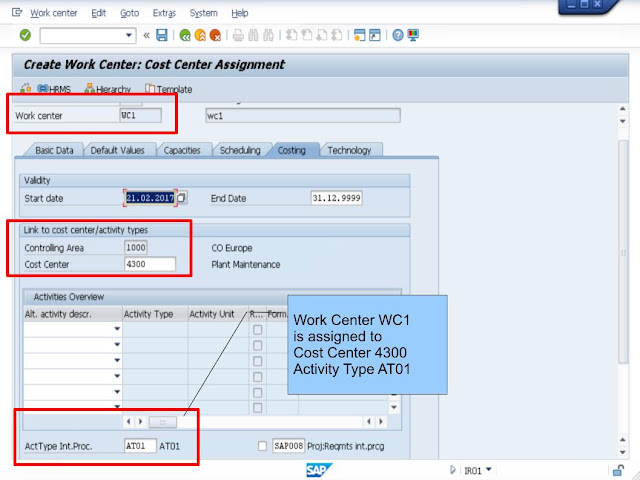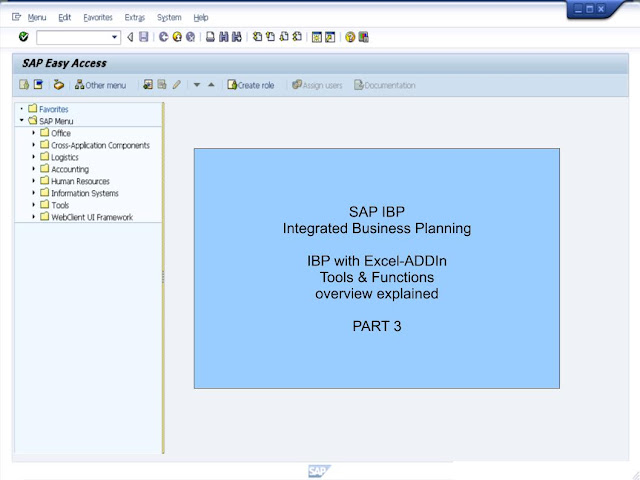This Blog is mainly on SAP Exam Questions and Selected "How-to" SAP processes
Thursday, January 27, 2022
Wednesday, January 26, 2022
Question no 3915 : Printing the Maintenance Order
(more than one answers)
A) At the time of Release.
B) After Release.
C) Before TECO.
D) After TECO.
E) Any time.
.
Answers: A, B, C
A) Put in Process have option to print.
B, C) From after Release to before TECO, the MO can be printed.
Monday, January 24, 2022
Question no 3914 : Order Type Default for Maintenance Order t-code IW31
(only one answer)
A) Transaction Code.
B) Sort list in the Order Type configuration.
C) Standard SAP only defaults PM01.
D) Technical Object.
E) Parameter ID.
.
Answer: E
via Parameter ID "AAI" below assigned to the User.
Friday, January 21, 2022
Wednesday, January 19, 2022
Question no 3913 : Activity Type
(only one answer)
A) Order Type.
B) Work Center.
C) Planning Plant.
D) Equipment.
E) Functional Location.
.
Answer: B
Work Center defaults.
Tuesday, January 18, 2022
Monday, January 17, 2022
Question no 3912 : Planning Plant in Plant Maintenance
(more than one answers)
A) General Maintenance Task List.
B) Maintenance Notification.
C) Maintenance Order.
D) Permit Master.
E) Catalog Profile.
.
Answers: A, C
Both D) Permit Master and E) Catalog Profile when created is without any Enterprise Structure definition (in this case not linked to any Plant).
C) MO header initial screen requires a Planning Plant.
Saturday, January 15, 2022
Wednesday, January 12, 2022
Question no 3911 : Task List Selection in Maintenance Order
(only one answer)
A) Equipment.
B) Functional Location.
C) Assembly.
D) General Task List Group Number.
E) Maintenance Activity Type.
.
Answer: E
"To Reference Object" means the either Technical Objects (EQ or FL) and Assembly (in Priority from EQ to FL to Assembly entered in the Reference Object fields in the Header of the MO will be used to determine suitable Task List type "A", "E", and "T". (Answer A, B, C)
Monday, January 10, 2022
Question no 3910 : Maintenance Activity Type
(more than one answers)
A) Reporting for Maintenance Notification.
B) Reporting for Maintenance Order.
C) Reporting for Maintenance Items in Maintenance Plans.
D) Activity Price for Maintenance Order Operations.
E) Task Determination for Maintenance Operations.
.
Answers: B, C
IMG - PM/CS - Maint/Service Processing - Maint. & Service Orders - Function and Setting for Order Types - Maintenance Activity Type - Define Maintenance Activity Types
- Defaulted to the Maintenance Order Header when the Order Type is used.
- Defaulted to the Maintenance Plan Item when the Call Object is a Maintenance Order.
The Maintenance Activity Types are only used in Maintenance Orders and not for Maintenance Notifications, therefore Answer A can be eliminated:
B) Reporting for Maintenance Order. (The LIS for plant maintenance comes with some standard reporting/tracking dealing with the Maintenance Activity Types. )
Saturday, January 8, 2022
Wednesday, January 5, 2022
Question no 3909 : Purchasing Group
(more than one answers)
A) It is assigned to a Purchasing Organization in the Enterprise Structure Configuration.
B) Purchasing Groups are unique for each Purchasing Organization.
C) A Purchasing Group is assigned to the User in the IMG.
D) Purchasing Group in the Material Master is defaulted to the Purchase Order Header.
E) Purchasing Group in the Material Master is defaulted to the Purchasing Info Record.
.
Answers: D, E
A, B) Purchasing Group is not Enterprise Structure related, it is independent of Purchasing Organization and Plant.
a group of buyerwho are responsible for procurement of material or service for day to day activities.
an individual buyer
Material Master - Purchasing data view at the Plant levelVendor Master - Purchasing Organization data view (last check only available in S/4)Purchasing Info Record - Purchasing Organization data view (with or without Plant level)Purchase Requisition - Item levelPurchase Order - Header levelRFQ/Quotation - Header levelContract - Header levelScheduling Agreement - Header level
**** the reason why SAP did not define Purchase Group at the Item level of RFQ/Quotation, PO, Contract, or Scheduling agreement is because they should be only ONE Buyer or Buyer Group responsible for these EXTERNAL Purchasing Documents. It is ILLOGICAL for MORE than ONE Buyer or Buyer Group to be responsible for each external Purchasing Document. Other then PR, all other External Purchasing Document Release Strategy are at the Header level; so using Header Purchasing Group for each External Purchasing Organization as Authorization influencing factor to determine the Authorization requirements will then also be correct.
**** however, for Purchase Requisition which is an INTERNAL Purchasing Document, the Purchasing Group is at the ITEM level. This is acceptable because a USER/DEPARTMENT can request for different Materials and Services in a Single Purchasing Requisition. Purchasing Requisition ITEMs in the SAME Purchase Requisition can then have Material and Services that contain different Purchasing Groups. In the PR to PO conversion process, the Buyer or Buyer Group can then filter Purchase Requisition ITEMs that they are responsible to be converted to RFQ, PO, Contract, or Scheduling Agreement. AND since only ONE Buyer or ONE Buyer Group is responsible for EACH of these EXTERNAL Purchasing Documents; therefore, the Purchasing Group is at the HEADER of these EXTERNAL Purchasing Documents.
**** if is IMPORTANT to ensure that each EXTERNAL Purchasing Document (RFQ, PO, Contract, Scheduling Agreement) contains Material or Service that belong to the SAME Purchasing Group which is recorded at the HEADER of the EXTERNAL Purchasing Document; then only the Purchasing Analytics for Purchasing Group will be correct.
The Purchasing Group in the Material Master can also be defaulted to the Purchase Requisition item.Monday, January 3, 2022
Question no 3908 : Reference Purchasing Organization
(more than one answers)
A) Create Purchase Order with reference to a Contract created by another Purchasing Organization.
B) Copy Plant condition Prices from Central Contract to the Purchase Order.
C) Allow source determination for Outline Agreements.
D) Create Scheduling Agreement with reference to a Contract created by another Purchasing Organization.
E) Copy Plant condition Prices from Central Contract to the Scheduling Agreement.
.
Answers: A, B
Its for Central Contract Scenario with Purchasing Organization for the Contract as a Reference Purchasing Organization so that Purchase Order created by another Purchasing Organization can be referenced to it.


























